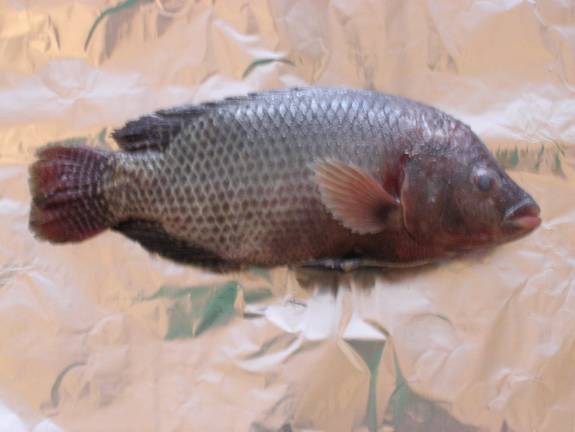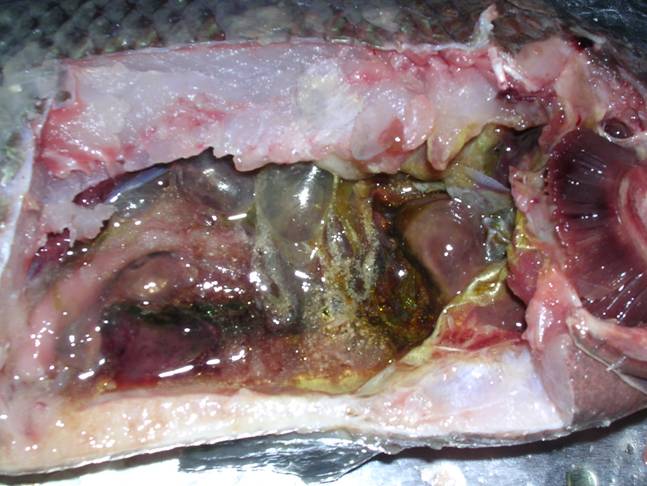
NAME:
HOMEROOM:
Fish Dissection External features:
1. Feel the fish's scales. Use a microscope to observe the scales up close, do you see rings? Why do fish have scales? __________________________________________________________________
________________________________________________________________________________
2. Find the lateral line. Discuss what it is used for and the way it works. _________________________________________________________________________________
3. Look at the overall shape of the fish and the placement of the fins. Imagine the Tilapia in the water, how does it move? Which fins are used for swimming? _________________________________________________________________________________
___________________________________________________________________________________

5. Feel the boney rays that support the dorsal fin. What function do these boney rays have for the fish? ____________________________________________________________________________
_________________________________________________________________________________
6. Locate the nostrils. What are they used for? __________________________________
7. Open the mouth, feel the gums and surrounding area. Feel the teeth along the gum margins and on the roof of the mouth. Do fish chew? Does the tongue feel like a human tongue? See how wide the mouth can open. Why is this? _____________________________________________________________________________________

10. The mouth is also used for breathing. In low oxygen conditions, fish can actively pump water over their gills by opening and closing their mouth. Try this, relating it to the action of a pump.
11. The gills arches can be seen by looking down the fish's mouth. Use a probe to separate the arches and explore how they are arranged.
12. Place the fish on its side and look at the operculum, the boney plates which protect the gills. Lift the operculum and look at the gills. Now cut the operculum away at its base, exposing the gills.

13. Remove the gills by cutting the upper and lower attachments of the arch. Look at the gill rakers, the boney projections along the inside curve of the arches. Observe the large surface area provided by the gill filaments, and the thin tissue which allows blood vessels to come into contact with the oxygen in the water. How do the gills work? ________________________________________________________________________________________
14. Note the size of the eye. Its relatively large size, and the large pupil, tells us how important vision is for this animal. Are there eyelids? Observe the tough, clear membrane that covers the eye, the cornea. Rotate the eye in its socket with your finger, now cut it out. After the eye has been removed, cut through the cornea and remove the lens. What is the purpose of the lens? _____________________________________________________________________________________________

Internal Organs:
1. Carefully cut the fish open using scissors (up from the anus to the bottom of the jaw, taking care not to cut into the fish's internal organs). Before moving any organs, see how everything fits together. Label the organs in the picture below as you go through the dissection.

![]()
2. Look for the swim bladder. It is made of very thin tissue and is located in the upper body cavity, below the kidneys. What is the swim bladders function? ___________________________________
______________________________________________________________________________________________
3. Investigate the digestive track by starting in the mouth and following the route that food would take. Put the probe through the mouth and into the esophagus to show the beginning of the route. Then follow the course of the stomach to the intestine and finally to the anus using your finger.
4. The liver is just in front of the stomach. The gall bladder is a mass of darker tissue on the liver. The spleen is a reddish organ and can be seen by lifting the stomach. What system of the body are the spleen and liver a part? ________________________________________________________
What is the function of the liver and the spleen? __________________________________________
_________________________________________________________________________________
5. Carefully remove the digestive organs and find the reproductive organs. The male reproductive organs will be white or orange tissue near the intestines. Eggs may or may not be noticeable in females. Both will vary in size depending on maturity of the fish. What sex is your fish? _________________________________________________________________________________
6. Put the fish on its back and find the kidneys, located just under the backbone. They are thin, dark in color, and run the whole length of the body cavity. What is the function of the kidneys? ______________________________________________________________________________________________
7. A fish's heart is almost literally in its mouth. It can be found by moving the liver. You should be able to make out the different chambers. The fact that the gills, heart and liver are so close together is no coincidence. Blood pressure is best near the pump (heart). Blood is filtered by the liver, and absorbs oxygen from the gills; both are vital functions. Why does the fish have a heart? _______________________________________________________________________________________________

8. Carefully expose the muscles and skeleton, by lifting the skin while running the scalpel along the backbone (see the picture).
9. Remove as much muscle as you can, so that you are able to see all of the vertebrae and ribs.

Notice how the body is supported by the vertebrae and the spines coming off of them. Now break the spinal cord and remove one of the vertebrae for closer examination. What does a single vertebrae look like? Draw what it looks like in the box below.

Congratulations, you have successfully dissected a fish!!